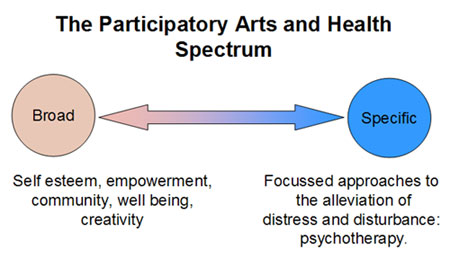Art Psychotherapy
Image ‘language’ comes before verbal language. Play, metaphoric and symbolic thinking are universal human behaviours, and have a powerful adaptive advantage as problem solving strategies.
Art making helps people tell their stories, express themselves, contain feelings, improve self esteem, and find new solutions to old problems, in other words to improve the 'Autobiographical Competence' and ‘Affective Processing’ identified as the aims of psychotherapy.
Making images means moving between being very involved with them and standing back. This can help people find new ways of dealing with feelings. Emotional intelligence is about neither having to deny our feelings, nor to be overwhelmed by them. Therapeutic art making develops and models this process of emotional regulation.
There is sometimes a fear that introducing psychotherapeutic thinking somehow undermines creative processes. In reality artists often find that their work is enriched, deepened and liberated by this approach. As veteran international artist Louise Bourgeois said:
‘Art is not about art. Art is about life. All art comes from terrific failures and needs that we have. It is about the difficulty of being a self because one is neglected. Everywhere in the modern world there is neglect and the need to be recognised, which is not satisfied. Art is a way of recognising oneself.’
Louise Bourgeois also says that psychotherapy was essential to her extraordinary making. Art psychotherapists work with people, rather than do things to them.
Pictures don’t have a set ‘meaning’ that therapists secretly or openly ‘interpret’. Pictures are really helpful parts of conversations, often seen as a three way conversation between client, image and therapist, from which meaning emerges. One of the beauties of images is that they can ‘mean’ many things simultaneously. Working with this improves cognitive fluidity, and often brings into question negative core beliefs.
These factors work best when there is a helping relationship with someone who is: experienced in art making - all Art Psychotherapists are artists first; aware of its psychological and emotional implications, who understands therapeutic relationship and are aware of its psychological and emotional implications. The most robust research finding in psychological therapies is that understanding therapeutic relationship is the most important skill in helping people.
Art Psychotherapy is part of a spectrum of opportunities making links between art and health. No one owns the creative aspect of human nature. But there are real skills involved in maximising these benefits where there is deep distress or disturbance. Many of us, (therapists included!) have needed psychological help at difficult times in our lives. There should be no stigma attached to needing, receiving, or offering skilled help. Art Psychotherapists are trained to offer this. Art Psychotherapy Training is two years full time postgraduate level. It is a psychological treatment, and is regulated by the Health Profession Council. (See links).
The psychotherapy-participatory arts spectrum can be seen like this:

Art Psychotherapy differs from art groups run by other professionals or volunteers. Although these groups are often enriching and enjoyable experiences and can aid self confidence, they are not psychological treatments. They are not attempting to help people understand their deeper feelings or find ways of coping more effectively with their difficulties. Nevertheless, there is a spectrum of skills, both interpersonal and creative that are valuable across the spectrum. This where Insider Art likes to work.
For further information about Art Psychotherapy, including a downloadable information pack, visit the British Association of Art Therapists website. (See links)
